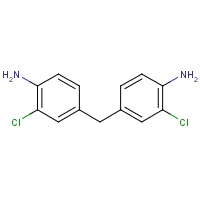MBOCA
Agent Name
MBOCA
Alternative Name
4,4'-Methylene bis (2-chloroaniline) (MOCA)
CAS Number
101-14-4
Formula
C13-H12-Cl2-N2
Major Category
Plastics & Rubber

Synonyms
4,4'-Methylene bis (2-chloroaniline); 3,3'-Dichlor-4,4'-diaminodiphenylmethan [German]; 3,3'-Dichloro-4,4'-diaminodifenilmetano [Italian]; 3,3'-Dichloro-4,4'-diaminodiphenylmethane; 3,3'-Dicloro-4,4'-diaminodifenilmetano [Italian]; 4,4'-Diamino-3,3'-dichlorodiphenylmethane; 4,4'-Methylene(bis)-chloroaniline; 4,4'-Methylenebis(2-chloroaniline); 4,4'-Methylenebis(o-chloroaniline); 4,4'-Methylenebis-2-chlorobenzenamine; 4,4-Metilene-bis-o-cloroanilina [Italian]; Aniline, 4,4'-methylenebis(2-chloro-; Benzenamine, 4,4'-methylenebis(2-chloro-; Bis amine; Bis(3-chloro-4-aminophenyl)methane; Bis(4-amino-3-chlorophenyl)methane; Bis-amine A; Bisamine; Bisamine S; CL-Mda; Cuamine M; Cuamine MT; Curalin M; Curene 442; Cyanaset; Dacpm; Di(-4-amino-3-chlorophenyl)methane; Di-(4-amino-3-clorofenil)metano [Italian]; Diamet Kh;LD 813; MOCA; MOCA (curing agent); Mboca; Methylene 4,4'-bis(o-chloroaniline); Methylene-bis-orthochloroaniline; Methylenebis(3-chloro-4-aminobenzene); Methylenebis(chloroaniline); Millionate M; Quodorole; p,p'-Methylenebis(alpha-chloroaniline); p,p'-Methylenebis(o-chloroaniline); p,p'-Methylenebis(ortho-chloroaniline); [ChemIDplus]
Category
Curing Agents (Aromatic)
Description
Tan-colored pellets or flakes with a faint, amine-like odor; [NIOSH]
Sources/Uses
Used as a curing agent for polyurethanes and epoxy resins; [ACGIH]
Comments
Causes hematuria, bladder cancer, and methemoglobinemia in animal toxicology studies; Listed in the table "Examples of Industrial Chemicals for Which Methemoglobin Formation is NOT the Principal Cause of Toxicity"; “MBOCA has been clearly carcinogenic in rats, mice, and dogs after oral administration. In rats, lung and liver tumors were the most prominent. In mice, an increased incidence of hepatomas was seen in females. In dogs, bladder tumors were observed. . . . Hematuria has been reported in a small group of workers exposed to MBOCA together with a variety of other materials at unmeasured concentrations, e.g., toluene diisocyanate, polyester resins, and polyether resins. The urinary conditions were mild and cleared within a week. . . . ACGIH encourages implementation of a urine monitoring program to ensure the effectiveness of dermal exposure controls . . . . Data indicative of bladder cancer in workers exposed to MBOCA were inconclusive." [ACGIH] "In most cases, dermal absorption after contact with contaminated surfaces is the most important occupational exposure route, with inhalation and ingestion representing minor exposure pathways. . . . The genotoxicity of 4,4′-methylenebis(2-chlorobenzenamine) is well documented and its toxicological profile is similar to that of orthotoluidine, thus indicating a common mode of action. 4,4′-methylenebis(2-chlorobenzenamine) has been shown to interact with DNA to form adducts in urothelial cells, and with haemoglobin to form adducts in the blood of workers exposed to this compound. . . . No adequate epidemiological studies were available to the Working Group to evaluate an association between MOCA and bladder-cancer risk." [Reference #1] Listed in Table 1 (Group 1 agents evaluated in the IARC Monographs Volumes 1-120, excluded from primary list of occupational carcinogens). Reason for exclusion: Group 1 classification based on mechanistic upgrade. [PMID 29769352]
Reference Link #1
Biomedical References
Exposure Assessment
BEI
Total MBOCA in urine = screen at end of shift;
Skin Designation (ACGIH)
Yes
TLV (ACGIH)
0.01 ppm, inhalable fraction and vapor
Vapor Pressure
3.9E-06 mm Hg
Explanatory Notes
VP from HSDB;
Half Life
Urine: 23 hours to several days; [TDR, p. 856]
Reference Link #2
Adverse Effects
Methemoglobinemia
MetHgb is secondary toxic effect
IARC Carcinogen
Established
NTP Carcinogen
Anticipated human carcinogen
ACGIH Carcinogen
Suspected Human
Diseases, Processes, and Activities Linked to This Agent
Processes
Industrial Processes with risk of exposure: